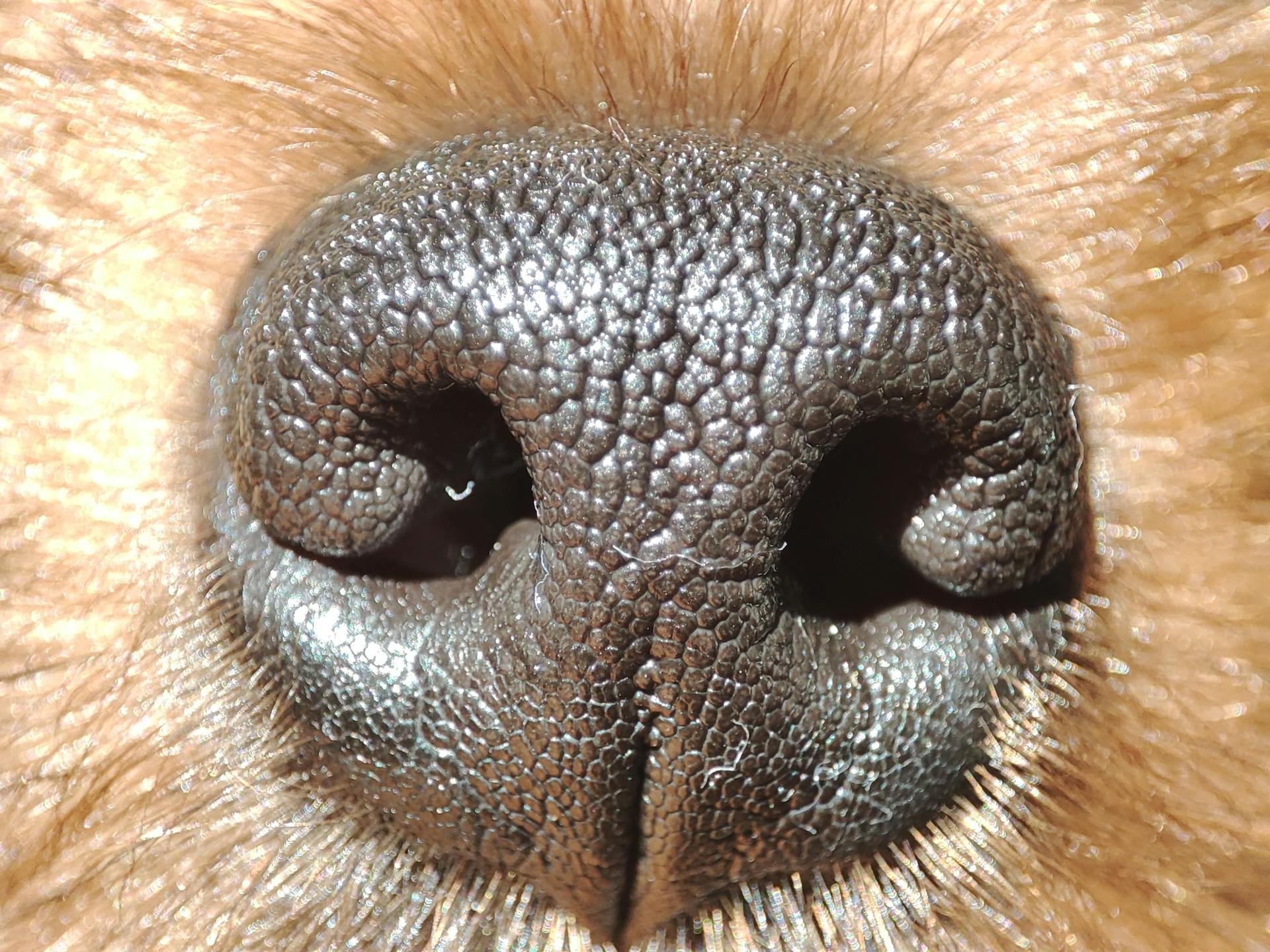
A Yorkshire Terrier liver shunt is a serious condition that can affect your little dog's life expectancy and overall health. It's a congenital anomaly where the blood flow to the liver is abnormal, leading to poor liver function and potentially life-threatening complications.
The liver is responsible for filtering toxins from the blood, so a shunt can cause a buildup of toxins in the body. This can lead to symptoms such as vomiting, diarrhea, and lethargy.
In severe cases, a liver shunt can cause a buildup of ammonia in the blood, leading to seizures, tremors, and even coma. If left untreated, a liver shunt can be fatal.
The good news is that a liver shunt can be diagnosed with imaging tests such as ultrasound or CT scans, and surgery can be performed to correct the issue.
A unique perspective: Yorkshire Terrier Pooping Blood
Causes and Types
A liver shunt in a Yorkshire Terrier can be a congenital condition, meaning it's present from birth, or it can develop later in life due to liver disease.
Congenital portosystemic shunts are a type of liver shunt that can affect Yorkshire Terriers.
These shunts can be caused by excessive and sustained pressure within the portal vein, leading to the opening of nonfunctional vascular communications.
Acquired shunts, on the other hand, are more common in older dogs and can be seen in Yorkshire Terriers with cirrhosis, hepatitis, or liver neoplasia.
In acquired shunts, a number of vessels are usually affected, which is different from congenital portosystemic shunts.
What Is a Liver Shunt?
A liver shunt in dogs is an abnormal vessel that allows normal blood to bypass the liver and flow directly into the systemic circulation.
This means that blood from the digestive system, which normally enters the liver through the portal vasculature system, instead enters the body's general circulation.
As a result, the liver can't process toxins and nutrients properly, leading to an underdeveloped liver and abnormal metabolism.
Dogs with liver shunts may exhibit poor growth, abnormal behavior, increased thirst, and abnormal urination patterns.
The condition can be congenital, meaning it's present from birth, or acquired due to a diseased liver.
Certain breeds, such as the Yorkshire terrier, are predisposed to liver shunts, but any breed or size dog can be affected.
In the body, exogenous and endogenous toxins that are normally metabolized or eliminated by the liver accumulate, leading to a range of health problems.
Pathogenesis and Etiology
A congenital liver shunt is a common issue in Yorkshire Terriers, occurring in 80% of patients.
This type of shunt typically occurs as a single extrahepatic or single intrahepatic anomalous vessel.
In the case of Yorkshire Terriers, the portosystemic liver shunt is hereditary, which means it's passed down from parents to offspring.
This shunt is caused by the persistence of a duct that normally resolves after birth, which normally diverts blood from the digestive system away from the liver and directly into systemic circulation.
Congenital shunts are more common in dogs, representing approximately 75% of all canine cases.
In Yorkshire Terriers, the portosystemic liver shunt can be classified as either outside of (extrahepatic) or within (intrahepatic) the liver.
This classification is based on the location of the anomalous vessel.
Clinical Presentation
A liver shunt in your Yorkshire Terrier can be a challenging condition to spot, but knowing the common signs can help you identify the issue early on. The central nervous system signs are the most common, occurring in over three-quarters of all cases.
These signs can be quite vague, such as anorexia, depression, and lethargy. More specific signs include episodes of hyperactivity, head pressing and circling, disorientation, temporary blindness, weakness, excess salivation, seizures, and occasionally coma.
Vomiting and/or diarrhea are present in about two-thirds of cases. The onset of these signs may be connected with the recent ingestion of a protein-rich meal.
Evidence of lower urinary tract disease is present in approximately one-half of cases and is usually due to ammonium urate crystals. These crystals are formed because of excessive excretion of ammonia and uric acid in urine.
Some dogs, particularly those that develop signs later in life, have polydipsia and polyuria (excessive drinking and urination).
Here are some common clinical signs of a liver shunt in dogs:
- Increased thirst and urination
- Vomiting
- Pica
- Drooling
- Ataxia (lack of coordination), circling and pacing, especially after eating
Testing and Diagnosis
Testing and diagnosis for a Yorkshire Terrier liver shunt can be a multi-step process. A full physical examination is typically the first step, followed by blood work and urinalysis to assess liver function and detect any abnormalities in urine.
Your veterinarian may recommend additional blood tests, such as bile acid assays and blood ammonia levels, to evaluate liver function in your Yorkshire Terrier. These tests can help identify any underlying liver insufficiency or illness.
Ultrasound is often used as a diagnostic imaging tool to visualize the liver and detect any shunts. The ultrasonographic appearance of a liver shunt can vary depending on its location and type, but typically there is increased liver echogenicity and dilation of the portal vein.
In some cases, your veterinarian may need to perform a liver biopsy to confirm the diagnosis and rule out other conditions.
Treatment and Prognosis
Surgery is often the treatment of choice for most dogs with a liver shunt.
The prognosis for dogs with liver shunts depends on several factors, including the severity of clinical signs, underlying cause, and whether surgery is performed.
If your Yorkshire Terrier survives the immediate postoperative period, the prognosis is excellent.
Medical therapy can be used to manage liver shunts, but it cannot correct the underlying condition.
Dogs that have surgery generally have a good prognosis, with about 90% of surgically treated patients still alive after 1500 days.
Medical therapy can be used to manage liver shunts in older dogs or those with mild clinical signs, but it is not as effective as surgery.
The success rate of surgery for liver shunts is about 85%, with signs recurring in 40-50% of animals with partial shunt ligation after 3 years.
Nutritional support is essential in the management of liver shunts, and dietary manipulations can help reduce neurotoxin production and absorption.
Supplementation with zinc salts and lactulose can also improve the detoxification of ammonia and control of hepatic encephalopathy.
Antibiotics are often used to reduce bacteria in the large intestine that produce neurotoxins.
Explore further: Are American Staffordshire Terriers Good Dogs
Prevention and Special Care
To prevent a portosystemic shunt in your Yorkshire terrier, it's essential to understand that the condition is not contagious. Regular veterinary care and monitoring of symptoms can help detect chronic liver disease early on.
Feeding your Yorkie a special diet can also play a crucial role in managing the condition. Veterinarians recommend a highly digestible protein intake of 4 g/100 kcal, which can be gradually increased if tolerated.
Eating small, frequent meals can help promote protein tolerance, and dietary restrictions on manganese and copper are also recommended.
Prevention
Prevention is key to managing portosystemic shunts (PSS) in animals.
Portosystemic shunts are not contagious, so you don't have to worry about your pet catching it from another animal.
However, it's essential to take preventative measures to ensure your pet's health.
Regular veterinary care and monitoring of symptoms can allow for earlier detection of acquired PSS, which is associated with chronic liver disease.
If you have a pet with a PSS or one that's closely related to an affected animal, it's recommended not to breed them to prevent the condition from passing on to their offspring.
Additional reading: Yorkshire Terrier Not Eating
Do I Need a Special Diet?
Dogs with a portosystemic liver shunt require a special diet.
The recommended feeding rate is 4 g/100 kcal of highly digestible protein. This is a crucial aspect of their diet.
Increases in protein may be introduced gradually if tolerated. It's essential to monitor their response to these changes.
Eating small, frequent meals can help promote protein tolerance. This can also make mealtime more manageable for both you and your dog.
Dietary restrictions are also recommended for manganese and copper. Be sure to follow your veterinarian's guidance on these essential nutrients.
Avoid giving your dog certain medications that are metabolized by the liver, such as NSAIDs and barbiturates.
On a similar theme: What Do Yorkshire Terriers Eat
Changing a Dog's Behavior
As a dog owner, it's normal to wonder if a liver shunt can affect your dog's behavior. Yes, they can change a dog's behavior as a result of a portosystemic liver shunt.
Dogs with liver shunts may exhibit changes in behavior due to secondary hepatic encephalopathy. This condition causes a buildup of toxins and ammonia in the bloodstream.
You might notice your dog acting lethargic, anxious, or even aggressive. These changes can be subtle, but they're worth paying attention to.
Changes in behavior can also be a sign that your dog needs medication or a special diet to manage their condition.
Discover more: Best Yorkshire Terrier Names
Key Information
A Yorkshire terrier liver shunt is a serious condition that can affect your furry friend's health. It's a portosystemic shunt (PSS) where blood flow bypasses the liver, allowing toxins to enter the bloodstream.
Symptoms can include uncoordinated gait, seizures, vomiting, diarrhea, and excessive urination. These symptoms can be caused by toxins not being filtered by the liver.
The condition can be either congenital or acquired. This means it can be present from birth or develop later in life.
Diagnostics involve a physical exam, blood work, urinalysis, and diagnostic imaging. These tests can help identify the presence of a liver shunt.
Treatment options vary depending on whether the shunt is congenital or acquired. Surgery is often the treatment for congenital PSS, while acquired PSS requires medical and nutritional management.
The prognosis for Yorkshire terriers with a liver shunt is generally good, especially if symptoms can be controlled adequately.
Frequently Asked Questions
How long can a Yorkie live with a liver shunt?
Yorkies with a liver shunt can live for 2 months to 2 years with proper medical management. However, their lifespan varies greatly depending on the individual case and the effectiveness of treatment
How much does it cost to fix a liver shunt in a dog?
The cost to fix a liver shunt in a dog can range from $2,000 to $12,000, depending on the complexity of the procedure and the number of affected blood vessels. Additional costs for medications, hospitalization, and follow-up care will also apply.
Sources
- https://www.dvm360.com/view/portosystemic-shunts-dogs-proceedings
- https://www.kingsdale.com/liver-shunt-in-dogs-causes-symptoms-and-treatment
- https://smallanimal.vethospital.ufl.edu/clinical-services/surgery/soft-tissue-surgery/portosystemic-shunts/
- https://vetster.com/en/conditions/dog/portosystemic-shunts
- https://www.centrevillesquareanimalhospitalva.com/blog/liver-shunts-in-pets-warning-signs-treatments-and-breeds-most-at-risk/
Featured Images: pexels.com


